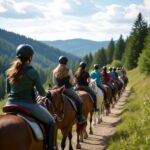You have signed up for an endurance riding event, and now it’s time to ensure you and your horse are ready for the challenge ahead. Proper preparation is key to a successful ride that is both enjoyable and safe. In this guide, you will learn imperative tips and steps to get both physically and mentally prepared for the endurance ride of a lifetime. Let’s get started!


Understanding the Basics of Endurance Riding
What is Endurance Riding?
Endurance riding is a competitive equestrian sport where horse and rider teams complete a long-distance race over varied terrain and challenging conditions. The goal is to finish the course in the best condition possible within a set time. Endurance rides can range from 25 miles to over 100 miles, testing the stamina, fitness, and teamwork of both horse and rider.
Types of Endurance Riding Events
Endurance riding events can be categorized into different types based on distance and difficulty level. Some common types include Competitive Trail Rides (CTR), Limited Distance rides (LD), and Endurance Rides (ER). Each type offers unique challenges and requires specific training and conditioning for both the horse and rider. Knowing the differences between these events will help you choose the right one to participate in.
| Competitive Trail Rides (CTR) | 20-45 miles |
| Limited Distance rides (LD) | 25-35 miles |
| Endurance Rides (ER) | 50-100 miles |
| Multi-day rides | Over 100 miles, completed over multiple days |
| International rides | Endurance rides that follow FEI rules and regulations |
Assuming you are new to endurance riding, starting with shorter distance events like CTR or LD can be a good way to ease into the sport and build up your skills and experience. Knowing the types of endurance riding events will help you set suitable goals and prepare effectively for the specific challenges of each.
Benefits of Participating in Endurance Riding Events
Riding in endurance events offers numerous physical, mental, and emotional benefits. The long hours spent in the saddle can improve your cardiovascular fitness, muscle strength, and endurance. Additionally, the bond formed between you and your horse during training and competition can be deeply rewarding.
You will also develop excellent horsemanship skills, learn to navigate challenging terrains, and hone your strategic planning abilities during an endurance ride. Another benefit of participating in endurance riding events is the sense of accomplishment and pride that comes with completing a demanding and grueling challenge. Importantly, the camaraderie and support within the endurance riding community can make the experience even more fulfilling and enjoyable.
Factors to Consider When Preparing for an Endurance Ride
There’s a lot to think about when preparing for an endurance ride. From selecting the right horse to ensuring your rider fitness is up to par, every aspect plays a crucial role in your success on the trail.
Horse Selection and Training
Training your horse for an endurance ride is vital. You need a horse that is fit, healthy, and mentally prepared for the challenge ahead. Slowly build up your horse’s stamina and endurance through consistent training rides. Introduce them to various terrain and environments to ensure they are comfortable and confident on the trail.
Rider Fitness and Conditioning
Pertaining to rider fitness and conditioning, your physical and mental preparedness can greatly impact your performance during an endurance ride. Make sure to incorporate regular cardio and strength training into your routine to build endurance and stamina. Additionally, focus on mental preparation techniques such as visualization and goal setting to keep you motivated and focused during the event.
For instance, practicing yoga or meditation can help you stay calm and centered during the long hours in the saddle, while also improving your flexibility and core strength.
Nutrition and Hydration Strategies
An important factor to consider when preparing for an endurance ride is your nutrition and hydration strategies. Properly fueling your body with balanced meals and staying hydrated before, during, and after the event is crucial for optimal performance. Pack high-energy snacks and electrolyte drinks to refuel on the trail and prevent dehydration.
Horse hydration is also key, so be sure to provide your horse with ample water and electrolytes throughout the ride to prevent fatigue and heat stress.
Equipment and Tack Essentials
While fitness and preparation are vital, having the right equipment and tack is equally important. Invest in quality gear that is comfortable and durable for both you and your horse. Ensure your saddle fits properly and won’t cause any discomfort or pain during long hours of riding.
Having a well-fitted bridle, saddle pads, and protective boots for your horse can prevent injuries and ensure they are comfortable throughout the ride. Properly maintaining your equipment and performing regular safety checks before the event can help prevent any issues while on the trail.

Creating a Training Plan
Setting Realistic Goals and Objectives
All great accomplishments start with a goal in mind. To set yourself up for success in your endurance riding event, it’s necessary to establish realistic goals and objectives. Consider factors such as your current fitness level, your horse’s abilities, and the timeframe until the event. By setting achievable goals, you can track your progress and stay motivated throughout your training.
Developing a Conditioning Program for Your Horse
You need to tailor a conditioning program that will gradually prepare your horse for the endurance event. This involves building up their stamina, muscle strength, and cardiovascular endurance over time. Consider consulting with a professional trainer to create a customized plan that suits your horse’s individual needs and abilities.
This will help prevent injuries and ensure that your horse is in optimal physical condition for the demands of the endurance ride.
Incorporating Cardio and Strength Training for Riders
Strength training for riders is just as important as cardiovascular conditioning. You should focus on exercises that improve your core strength, balance, and overall fitness. By incorporating a mix of cardio and strength training into your routine, you’ll enhance your performance and reduce the risk of fatigue during the long ride.
Objectives like improving your endurance, flexibility, and muscle tone should be at the forefront of your training plan to ensure you’re physically prepared for the challenges ahead.
Scheduling Rest and Recovery Days
Training for an endurance riding event can be intense, but your body and your horse need time to rest and recover. You should schedule rest and recovery days into your training plan to prevent burnout and reduce the risk of overtraining injuries. Listen to your body and your horse’s cues – if you’re feeling fatigued or notice any signs of strain, it’s important to take a break and allow for proper recovery.
Recall, rest is just as crucial as training in preparing for a successful endurance ride.
Tips for Building Endurance and Stamina
Now that you have set your sights on an endurance riding event, it’s necessary to focus on building endurance and stamina to ensure you can successfully complete the challenge. Here are some tips to help you prepare:
Gradually Increasing Distance and Intensity
While it may be tempting to push yourself to ride long distances or at high speeds right from the start, this approach can lead to injury and burnout. Instead, gradually increase both the distance of your rides and the intensity of your workouts over time. By slowly building up your endurance base, you allow your body to adapt and strengthen, reducing the risk of overuse injuries. The key is to listen to your body and avoid ramping up too quickly.
Incorporating Hill Work and Interval Training
Stamina building through hill work and interval training can significantly improve your overall riding performance. Hills challenge your cardiovascular system and strength, helping you become a more well-rounded rider. Interval training, which involves alternating between high-intensity bursts of effort and periods of rest, can boost your anaerobic capacity and speed. Incorporating these workouts into your routine will not only enhance your endurance but also make you a more powerful rider.
Hill work forces you to work harder against gravity, building strength in your legs and core. It also mimics the varied terrain you may encounter during an endurance event, preparing you for any challenges that come your way.
Practicing Pacing and Speed Control
Training your body to maintain a steady pace and control your speed during long rides is crucial for endurance events. Plus, learning how to conserve energy and avoid going out too hard at the start will prevent fatigue later on. By practicing pacing and speed control in your training rides, you can develop a better sense of your limits and optimize your performance on event day.
It’s necessary to find a pace that allows you to cover the distance while still feeling strong and in control. Recall, the goal is to finish the event feeling accomplished and not completely depleted.
Building Mental Toughness and Focus
Control over your mind is just as important as control over your body when it comes to endurance riding. Building mental toughness and focus can help you push through tough moments during the event when your body wants to give up. Visualizing success, setting small achievable goals, and maintaining a positive mindset can all contribute to your mental resilience. Incorporating techniques such as breathing exercises and mindfulness meditation into your training routine can also help you stay calm and focused under pressure.
Pre-Ride Preparation and Logistics
Once again, it’s time to prepare for your endurance riding event. This chapter will focus on the pre-ride preparation and logistics you need to consider to ensure a smooth and successful experience on the day of the event.
Pre-Ride Checklists for Horse and Rider
There’s nothing worse than realizing you forgot an important item right before your ride starts. Make sure you have a pre-ride checklist for both you and your horse. For yourself, check that you have your riding attire, boots, helmet, hydration pack, snacks, and any necessary medications. For your horse, ensure you have your saddle, bridle, hoof pick, saddle pads, grooming kit, water buckets, and any required vet paperwork.
Packing Essential Items and Supplies
To ensure you have everything you need for the ride, it’s important to pack your items strategically. Organize your gear in a way that makes it easy to access during the event. Pack your supplies in a backpack or saddlebags that are secure and won’t shift during the ride. Don’t forget to pack enough water and electrolytes for both you and your horse to stay hydrated throughout the event.
Understanding the importance of each item you pack will help you prioritize and pack efficiently. Consider the weather conditions and terrain of the ride venue to pack accordingly. Having the right gear and supplies can make a significant difference in your comfort and performance during the event.
Understanding Course Markings and Navigation
Now, let’s talk about understanding the course markings and navigation for the ride. Course markings are crucial for staying on the right track and avoiding wrong turns. Familiarize yourself with the common trail markings used in endurance riding, such as ribbons, tapes, and signs. Knowing how to read these markings will prevent you from getting lost during the event.
Course familiarity can give you a competitive edge and boost your confidence during the ride. Study the course map before the event and pay attention to any tricky sections or landmarks. Being well-prepared in terms of course navigation will help you ride more efficiently and enjoy the experience to the fullest.
Familiarizing Yourself with the Ride Venue
Markings on the trail can guide you during the ride, so it’s important to pay close attention to any cautionary signs or markers that warn of obstacles or challenging terrain ahead. Knowing the ride venue’s layout and potential pitfalls can help you prepare mentally and physically for what’s to come.

Managing Risk and Minimizing Injuries
Identifying Potential Hazards and Risks
You are getting ready for an endurance riding event, and it is crucial to identify potential hazards and risks that you may encounter along the way. From challenging terrains to unpredictable weather conditions, being aware of these factors can help you better prepare and minimize the likelihood of accidents. Make sure to assess the trail conditions, watch out for any obstacles or hazards that may spook your horse, and be mindful of other riders around you.
Developing a Contingency Plan for Emergencies
Potential emergencies can happen during endurance riding events, so it is vital to have a solid contingency plan in place. **Knowing the location of the nearest veterinary checkpoints and the contact information of event organizers can be crucial in times of need.** Additionally, carrying a well-stocked first-aid kit for both you and your horse, as well as knowing basic first-aid procedures, can be lifesaving in emergency situations.
The contingency plan should also include a communication strategy in case you are separated from your horse or team members. Make sure your cell phone is fully charged and consider carrying a portable charger to stay connected throughout the event.
Pre-Ride Veterinary Checks and Horse Health
The health and well-being of your horse are paramount in endurance riding events. **Before the ride, ensure that your horse undergoes a thorough veterinary check to assess its fitness level and overall health.** Veterinarians will check vital signs, hydration levels, and overall soundness to ensure that your horse is in prime condition to take on the challenges of the event.
Pre-Ride Veterinary Checks and Horse Health
Rider safety is equally important, so incorporating injury prevention strategies into your preparation is key. **Make sure to wear appropriate safety gear, including a certified helmet, gloves, and proper footwear.** Additionally, consider training in advance to improve your riding skills and physical fitness to reduce the risk of injuries during the event.
Final Words
Upon reflecting on how to prepare for an endurance riding event, remember that success in these events relies heavily on your preparation. By following a training plan that gradually increases in intensity, fueling your body with the right nutrition, and ensuring your horse is fit and healthy, you will set yourself up for a successful ride. Pay attention to the details, such as proper gear, hydration, and mental preparation, to give yourself the best chance to reach the finish line.
Endurance riding events can be challenging but rewarding experiences. With dedication, consistency, and a positive mindset, you can tackle the miles ahead with confidence. Remember to trust in your training, listen to your body, and most importantly, enjoy the journey as you and your horse work together to complete the event.
Q: What is endurance riding?
A: Endurance riding is a competitive equestrian sport where horse and rider teams complete a marked long-distance trail ride within a set time, typically between 50 to 100 miles. The goal is to finish the ride in good condition within the specified time frame.
Q: How should I prepare my horse for an endurance riding event?
A: To prepare your horse for an endurance riding event, ensure they are in good health and fitness. Gradually increase their training and conditioning levels, focusing on building stamina, strength, and endurance. Work with a veterinarian to create a proper nutrition and hydration plan for your horse.
Q: What gear do I need for an endurance riding event?
A: Essential gear for an endurance riding event includes a well-fitted endurance saddle, saddle pad, bridle with bit, hoof boots or shoes, protective leg wraps, water bottles or hydration system, trail maps, GPS or compass, and a first aid kit for both horse and rider.
Q: How can I improve my own fitness for an endurance riding event?
A: Improve your own fitness for an endurance riding event by incorporating aerobic exercises like running, cycling, and swimming into your routine. Focus on strength training for your core and lower body to improve stability and balance while riding. Practice in the saddle for long hours to build endurance.
Q: What should I consider on the day of an endurance riding event?
A: On the day of an endurance riding event, arrive early to check in, prepare your horse, and familiarize yourself with the trail. Stay hydrated and eat a balanced meal before the ride. Pace yourself during the event, listen to your horse’s cues, and be prepared for any weather conditions or trail obstacles.










